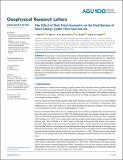Files in this item
The effect of melt pond geometry on the distribution of solar energy under first-year sea ice
Item metadata
| dc.contributor.author | Horvat, C. | |
| dc.contributor.author | Flocco, D. | |
| dc.contributor.author | Rees Jones, D.W. | |
| dc.contributor.author | Roach, L. | |
| dc.contributor.author | Golden, K.M. | |
| dc.date.accessioned | 2020-08-16T23:37:51Z | |
| dc.date.available | 2020-08-16T23:37:51Z | |
| dc.date.issued | 2020-02-17 | |
| dc.identifier | 266431715 | |
| dc.identifier | ed8332e1-5cb6-46c5-bf5a-4273e3990435 | |
| dc.identifier | 85081091735 | |
| dc.identifier | 000529120100048 | |
| dc.identifier.citation | Horvat , C , Flocco , D , Rees Jones , D W , Roach , L & Golden , K M 2020 , ' The effect of melt pond geometry on the distribution of solar energy under first-year sea ice ' , Geophysical Research Letters , vol. 47 , no. 4 , e2019GL085956 . https://doi.org/10.1029/2019GL085956 | en |
| dc.identifier.issn | 0094-8276 | |
| dc.identifier.other | Bibtex: doi:10.1029/2019GL085956 | |
| dc.identifier.other | ORCID: /0000-0001-8698-401X/work/69463630 | |
| dc.identifier.uri | https://hdl.handle.net/10023/20474 | |
| dc.description | CH was supported by the NOAA Climate and Global Change Postdoctoral Fellowship Program, sponsored in part through cooperative agreement number NA16NWS4620043, Years 2017–2021, with the National Oceanic and Atmospheric Administration, U.S. Department of Commerce. K.M.G. acknowledges support from the the Applied and Computational Analysis Program and the Arctic and Global Prediction Program at the US Office of Naval Research through grants N00014-13-10291, N00014-15-1-2455, N00014-18-1-2041, and N00014-18-1-2552, as well as support from the Division of Mathematical Sciences and the Division of Polar Programs at the U.S. National Science Foundation through Grants DMS-0940249, DMS-1413454, and DMS-1715680. LR was supported by Marsden contract VUW1408 and the Deep South National Science Challenge. | en |
| dc.description.abstract | Sea ice plays a critical role in the climate system through its albedo, which constrains light transmission into the upper ocean. In spring and summer, light transmission through sea ice is influenced by its iconic blue melt ponds, which significantly reduce surface albedo. We show that the geometry of surface melt ponds plays an important role in the partitioning of instantaneous solar radiation under sea ice by modeling the three-dimensional light field under ponded sea ice. We find that aggregate properties of the instantaneous sub-ice light field, such as the enhancement of available solar energy under bare ice regions, can be described using a new parameter closely related to pond fractal geometry. We then explore the influence of pond geometry on the ecological and thermodynamic sea-ice processes that depend on solar radiation. | |
| dc.format.extent | 3564084 | |
| dc.language.iso | eng | |
| dc.relation.ispartof | Geophysical Research Letters | en |
| dc.subject | Melt ponds | en |
| dc.subject | Sea ice | en |
| dc.subject | Phytoplankton blooms | en |
| dc.subject | Fractal geometry | en |
| dc.subject | Arctic | en |
| dc.subject | GE Environmental Sciences | en |
| dc.subject | QA Mathematics | en |
| dc.subject | DAS | en |
| dc.subject | SDG 13 - Climate Action | en |
| dc.subject.lcc | GE | en |
| dc.subject.lcc | QA | en |
| dc.title | The effect of melt pond geometry on the distribution of solar energy under first-year sea ice | en |
| dc.type | Journal article | en |
| dc.contributor.institution | University of St Andrews. Applied Mathematics | en |
| dc.identifier.doi | https://doi.org/10.1029/2019GL085956 | |
| dc.description.status | Peer reviewed | en |
| dc.date.embargoedUntil | 2020-08-17 |
This item appears in the following Collection(s)
Items in the St Andrews Research Repository are protected by copyright, with all rights reserved, unless otherwise indicated.

